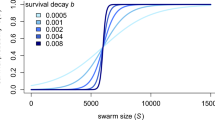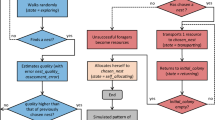Abstract
Organisms face a trade-off between investment in fewer, larger offspring, or more, smaller offspring. Most organisms can adjust investment through variation in the size and number of offspring in response to factors such as resource availability and competition. In some social animals, established colonies divide into groups of individuals that become autonomous, a process known as colony fission (also dependent colony foundation in social insects). Resource allocation under fission can be fine-tuned by adjusting the number of new groups (offspring number) and the number of individuals in each new group (offspring size). We assessed the influence of competition on resource allocation during fission in the ant Cataglyphis cursor, by allowing colonies to fission in experimental enclosures of high or low conspecific colony density. The pattern of colony fission was similar to that observed in the field: each fissioning colony produced a few new nests comprising a highly variable number of workers and a single queen, the old queen was often replaced, and new queens were produced in excess. The number of new nests produced depended on the available workforce in the parent colony but was not affected by differences in colony density. Comparison with data from fission under natural field conditions, however, indicates that colonies in enclosures produced fewer, larger new nests, suggesting that resource investment patterns during fission are indeed subject to extrinsic factors. The density of conspecific colonies in the immediate surroundings may be an unreliable estimate of competition intensity and other factors should be considered.


Similar content being viewed by others
References
Allen RM, Buckley YM, Marshall DJ (2008) Offspring size plasticity in response to intraspecific competition: an adaptive maternal effect across life-history stages. Am Nat 171(2):225–237. doi:10.1086/524952
Amor F, Ortega P, Jowers MJ, Cerdá X, Billen J, Lenoir A, Boulay R (2011) The evolution of worker–queen polymorphism in Cataglyphis ants: interplay between individualand colony-level selections. Behav Ecol Sociobiol 65:1473–1482. doi:10.1007/s00265-011-1157-7
Andersen AN (1992) Regulation of momentary diversity by dominant species in exceptionally rich ant communities of the Australian seasonal tropics. Am Nat 140(3):401–420
Andersen AN (2000) A global ecology of rainforest ants: functional groups in relation to environmental stress and disturbance. In: Agosti D, Majer JD, Alonso LE, Schultz TR (eds) Ants: standard methods for measuring and monitoring biodiversity. Smithsonian Institution Press, Washington DC, pp 25–34
Banks MA, Eichert W (2000) WHICHRUN (Version 3.2) a computer program for population assignment of individuals based on multilocus genotype data. J Hered 91:87–89
Bashey F (2008) Competition as a selective mechanism for larger offspring size in guppies. Oikos 117(1):104–113. doi:10.1111/j.2007.0030-1299.16094.x
Boulay R, Galarza JA, Chéron B, Hefetz A, Lenoir A, van Oudenhove L, Cerdá X (2010) Intraspecific competition affects population size and resource allocation in an ant dispersing by colony fission. Ecology 91:3312–3321
Bourke AFG, Franks NR (1995) Social evolution in ants. Princeton University Press, Princeton
Brockelman WY (1975) Competition, the fitness of offspring, and optimal clutch size. Am Nat 109:677–699
Cagniant H (1976) Distribution, écologie et nid de la fourmi Cataglyphis cursor Fonscolombe (Hyménoptères Formicidae). Vie Milieu 26:265–276
Cerdá X, Retana J, Cros S (1997) Thermal disruption of transitive hierarchies in Mediterranean ant communities. J Anim Ecol 66(3):363–374
Chéron B, Cronin A, Doums C, Fédérici P, Haussy C, Tirard C, Monnin T (2011) Unequal resource allocation among colonies produced by fission in the ant Cataglyphis cursor. Ecology 92(7):1448–1458. doi:10.1890/10-2347.1
Clémencet J, Doums C (2007) Habitat-related microgeographic variation of worker size and colony size in the ant Cataglyphis cursor. Oecologia 152(2):211–218
Clémencet J, Viginier B, Doums C (2005) Hierarchical analysis of population genetic structure in the monogynous ant Cataglyphis cursor using microsatellite and mitochondrial DNA markers. Mol Ecol 14(12):3735–3744
Cronin AL, Monnin T, Haussy C, Doums C (2011) Opportunities for mate choice in the fission performing ant Cataglyphis cursor. Ecol Entomol. doi:10.1111/j.1365-2311.2011.01291.x
Einum S, Hendry AP, Fleming IA (2002) Egg-size evolution in aquatic environments: does oxygen availability constrain size? Proc R Soc Lond B 269:2325–2330. doi:10.1098/rspb.2002.2150
Fischer K, Brakefield PM, Zwaan BJ (2003) Plasticity in butterfly egg size: why larger offspring at lower temperatures? Ecology 84:3138–3147
Fox CW, Czesak ME (2000) Evolutionary ecology of progeny size in arthropods. Annu Rev Entomol 45:341–369
Fox CW, Mousseau TA (1996) Larval host plant affects fitness consequences of egg size variation in the seed beetle Stator limbatus. Oecologia 107(4):541–548
Fox CW, Thakar MS, Mousseau TA (1997) Egg size plasticity in a seed beetle: an adaptive maternal effect. Am Nat 149(1):149–163
Hölldobler B, Wilson EO (2009) The super-organism. the beauty, elegance and strangeness of insect societies. Norton, New York
Hendry AP, Day T, Cooper AB (2001) Optimal size and number of propagules: allowance for discrete stages and effects of maternal size on reproductive output and offspring fitness. Am Nat 157(4):387–407
Lenoir A, Nowbahari E, Querard L, Pondicq N, Delalande C (1990) Habitat exploitation and intercolonial relationships in the ant Cataglyphis cursor (Hymenoptera, Formicidae). Acta Oecol 11(1):3–18
Lenoir A, Quérard L, Pondicq N, Berton F (1988) Reproduction and dispersal in the ant Cataglyphis cursor (Hymenoptera, Formicidae). Psyche 95(1–2):21–44
Marshall DJ, Cook CN, Emlet RB (2006) Offspring size effects mediate competitive interactions in a colonial marine invertebrate. Ecology 87(1):214–225
Molet M, van Baalen M, Peeters C (2008) Shift in colonial reproductive strategy associated with a tropical-temperate gradient in Rhytidoponera ants. Am Nat 172:75–87
Nonacs P (2000) Measuring and using skew in the study of social behavior and evolution. Am Nat 156:577–589
Olofsson H, Ripa J, Jonzén N (2009) Bet-hedging as an evolutionary game: the trade-off between egg size and number. Proc R Soc Lond B 276:2963–2969. doi:10.1098/rspb.2009.0500
Parker GA, Begon M (1986) Optimal egg size and clutch size-effects of environment and maternal phenotype. Am Nat 128(4):573–592
Parr CL, Gibb H (2010) Competition and the role of dominant ants. In: Lach L, Parr C, Abbott K (eds) Ant ecology. Oxford University Press, Oxford, pp 77–96
Pearcy M, Aron S (2006) Local resource competition and sex ratio in the ant Cataglyphis cursor. Behav Ecol 17(4):569–574
Pearcy M, Aron S, Doums C, Keller L (2004a) Conditional use of sex and parthenogenesis for worker and queen production in ants. Science 306:1780–1783
Pearcy M, Clémencet J, Chameron S, Aron S, Doums C (2004b) Characterization of nuclear DNA microsatellite markers in the ant Cataglyphis cursor. Mol Ecol Notes 4(4):642–644
Pearcy M, Hardy O, Aron S (2006) Thelytokous parthenogenesis and its consequences on inbreeding in an ant. Heredity 96:377–382
Peeters C, Ito F (2001) Colony dispersal and the evolution of queen morphology in social Hymenoptera. Annu Rev Entomol 48:601–630
Peeters C, Molet M (2010) Colonial reproduction and life histories. In: Lach L, Parr C, Abbott K (eds) Ant ecology. Oxford University Press, Oxford, pp 159–176
R Development Core Team (2010) R: A language and environment for statistical computing. R Foundation for Statistical Computing, Vienna
Ratnieks FLW (2001) Heirs and spares: caste conflict and excess queen production in Melipona bees. Behav Ecol Sociobiol 50:467–473
Rosenheim JA, Nonacs P, Mangel M (1996) Sex ratios and multifaceted parental investment. Am Nat 148(3):501–535
Sibly R, Calow P, Smith RH (1988) Optimal size of seasonal breeders. J Theor Biol 133(1):13–21
Smith CC, Fretwell SD (1974) Optimal balance between size and number of offspring. Am Nat 108(962):499–506
Stanton ML (1984) Seed variation in wild radish-effect of seed size on components of seedling and adult fitness. Ecology 65(4):1105–1112
Tschinkel WR (2006) The fire ants. Harvard University Press, Cambridge
Wenseleers T, Ratnieks FLW (2004) Tragedy of the commons in Melipona bees. Biol Lett 271:S310–S312
Acknowledgments
We would like to thank the Laboratoire Arago (Observatoire Océanologique de Banyuls-sur-mer, Université Pierre et Marie Curie) for permitting this study to take place on the experimental grounds of the Mediterranean Garden of Mas de la Serre, and the Coast Conservation Office (“Conservatoire du littoral”) for allowing the collection of ‘competitive’ colonies in a protected bird nesting area in Saint Cyprien. We are very grateful to Laurent Belkadi, Nathalie Guillory, Claudy Haussy, David Laloi, Jean-Christophe Lenoir and Claire Tirard for help in erecting the enclosures. We also thank Mathieu Molet for help collecting and installing colonies and Peter Nonacs, Alain Lenoir and three anonymous referees for helpful comments on this and an earlier version of the manuscript. This work was funded by ANR-06-BLAN-0268.
Author information
Authors and Affiliations
Corresponding author
Additional information
Communicated by Jérome Casas.
Electronic supplementary material
Below is the link to the electronic supplementary material.
Rights and permissions
About this article
Cite this article
Cronin, A.L., Fédérici, P., Doums, C. et al. The influence of intraspecific competition on resource allocation during dependent colony foundation in a social insect. Oecologia 168, 361–369 (2012). https://doi.org/10.1007/s00442-011-2098-6
Received:
Accepted:
Published:
Issue Date:
DOI: https://doi.org/10.1007/s00442-011-2098-6




